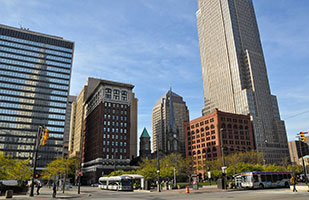Cleveland’s Curfew Ordinance for Public Square is Constitutional

The Ohio Supreme Court upheld the constitutionality of a city ordinance imposing a curfew on Cleveland’s Public Square. (Chris Gent)

The Ohio Supreme Court upheld the constitutionality of a city ordinance imposing a curfew on Cleveland’s Public Square. (Chris Gent)
The Supreme Court of Ohio today upheld a Cleveland city ordinance that prohibits people from staying in the city’s downtown Public Square overnight without a permit.
In a 6-1 decision written by Justice Judith Ann Lanzinger, the court determined that Cleveland’s ordinance does not violate the rights to free speech and assembly in the U.S. Constitution. Justice Lanzinger wrote that the law is content neutral, is narrowly tailored to advance a significant government interest, and allows alternative channels of speech.
The decision reverses the judgment of the Eighth District Court of Appeals.
A group known as Occupy Cleveland was protesting income disparity in the Public Square area of Cleveland on October 21, 2011. Around 10 p.m., police told the protesters that they had to leave because of the city’s curfew, which states that people cannot remain in the square between 10 p.m. and 5 a.m. without first obtaining a permit from the city.
Erin McCardle and Leatrice Tolls did not leave the area and were arrested. They both pled no contest to a curfew violation. Each appealed separately to the Eighth District Court of Appeals.
In a decision combining the cases, the Eighth District ruled that the ordinance violated the protesters’ right to free speech and assembly guaranteed by the First Amendment to the U.S. Constitution.
The city appealed to the Ohio Supreme Court, which agreed to hear the case.
In today’s opinion, Justice Lanzinger reasoned that Cleveland’s ordinance is content neutral because it applies to all people regardless of their message or activities and bans no particular message or form of expression.
She wrote that content-neutral regulations must meet three requirements to be found constitutional: “[T]he regulation must be narrowly tailored, it must serve a significant government interest, and it must leave open ample alternative avenues of communication.”
Justice Lanzinger noted that the city law states that a permit will be granted unless it “would (1) unreasonably threaten public health, welfare, or safety, (2) be unreasonably likely to incite violence or other unlawful activity, (3) impose excessive financial or operational costs on the city, or (4) interfere with another reservation of the same facility.”
Other case decisions have upheld these government interests as meeting the constitutional standard of review that applies in this case, Justice Lanzinger wrote, so Cleveland’s stated interests justify the restrictions.
The court also determined that the ordinance is narrowly tailored because it only prohibits public expression in the square during late night and early morning hours and because the city’s interests would be met “less effectively” without the law.
Last, the ordinance excludes the streets and public sidewalks adjacent to the square from the curfew and permit requirements, so “the protestors could have simply moved off the grass and onto the public sidewalk surrounding the Public Square,” Justice Lanzinger wrote. “They had unrestricted access to the sidewalks adjacent to Public Square and had 17 hours in which they could have been in the square without a permit.” She concluded that the city’s law provides other channels of communication.
Cleveland’s law setting a curfew in Public Square meets the necessary conditions to be found constitutional under the U.S. Constitution’s First and Fourteenth Amendments, the court ruled.
Joining the majority were Chief Justice Maureen O’Connor and Justices Terrence O’Donnell, Sharon L. Kennedy, Justice Judith L. French, and William M. O’Neill.
Justice Paul E. Pfeifer dissented. He asserts that the city’s law is unconstitutional because it is not narrowly crafted to further a significant government interest.
“[T]he ordinance would not prohibit 1,000 Ohioans, or foreigners for that matter, from marching from one side of the public square to the other, over and over, all night, as long as they do not remain in Public Square,” Justice Pfeifer wrote. “How can an ordinance that prohibits one person from remaining in Public Square be considered narrowly tailored to serve a significant government interest when the same ordinance allows 1,000 people or 100 people or one person to walk back and forth through the park all night?”
2013-0096. Cleveland v. McCardle, Slip Opinion No. 2014-Ohio-2140.
 View oral argument video of this case.
View oral argument video of this case.
Please note: Opinion summaries are prepared by the Office of Public Information for the general public and news media. Opinion summaries are not prepared for every opinion, but only for noteworthy cases. Opinion summaries are not to be considered as official headnotes or syllabi of court opinions. The full text of this and other court opinions are available online.
Acrobat Reader is a trademark of Adobe Systems Incorporated.


